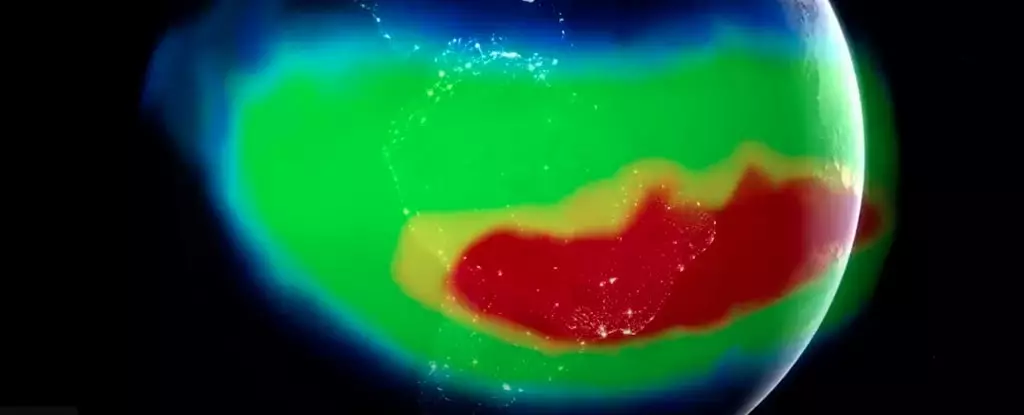The South Atlantic Anomaly (SAA) is not merely a zone of irregular magnetic activity; it stands as a testament to the dynamic nature of our planet’s geomagnetic environment. Stretching from the skies of South America to the southwestern coast of Africa, this peculiar region is characterized by a significant drop in magnetic intensity—a great concern for scientists and researchers, especially from institutions like NASA. While Earth’s magnetic field generally acts as a shield against cosmic hazards, the SAA opens a fascinating yet alarming window into our planet’s interior dynamics.
The preeminence of NASA in monitoring the SAA underlines its significance in contemporary space exploration. The anomaly manifests itself as an unusual ‘dent’ or ‘pothole in space’ within Earth’s geomagnetic field, exposing satellites and other spacecraft to potential dangers from high-energy particles emitted by the Sun. With the International Space Station (ISS) and numerous satellites orbiting through this low-Earth region, the implications of the SAA are magnified. Each venture into this magnetic dip requires strategic precautions, revealing the delicate balance of challenges posed by space exploration against the backdrop of Earth’s intricate magnetic fabric.
The Vulnerability of Modern Technology
For the agencies and organizations that operate spacecraft, the stakes are high; the exposure to the SAA can result in catastrophic failures. At its most benign, technical glitches might arise, creating minor data inaccuracies. However, the more sinister implications could result in irreparable damage to vital systems. To mitigate these risks, satellite operators are forced to enact rigorous protocols designed to protect their costly and critical machinery. Such precautions, while effective, are a stark reminder of the unpredictable obstacles that arise when humanity ventures into the cosmos.
The perplexing characteristics of the SAA present not just a risk but an opportunity—a chance to dive into the enigmatic forces shaping Earth’s magnetic field. As NASA’s Terry Sabaka so aptly stated, the geomagnetic field is a culmination of numerous currents beneath Earth’s surface, particularly influenced by the molten iron swirling in the outer core. It’s during moments like these, when the interplay of geology and physics draws our attention, that we are reminded of how relatively little we grasp the enormity of our planet’s magnetic wonders.
The Foundations of the Anomaly
The source of the anomaly is thought to be deeply entrenched in the African Large Low Shear Velocity Province, a colossal region beneath the continent that disrupts the magnetic field generator. Magnetic forces are complex, and an understanding of the SAA requires examining layers of geology that lie thousands of kilometers below. The diversification of the magnetic field, with its conscious reversal in polarity, raises unsettling questions about stability and the long-term implications of these changes.
Emerging insights from ongoing studies have revealed that the anomaly is neither static nor an isolated occurrence. Data indicates a slow drift of this magnetic irregularity, a fact underscored by recent observations from CubeSats. The significance of this drift must not be underestimated; a shift in the SAA could influence anything from satellite functionality to Earth’s magnetic behavior over geological timeframes. Perhaps most astonishing is the revelation that scientists suspect the anomaly is undergoing a division into two distinct regions of minimum magnetic intensity, a phenomenon that merits rigorous investigation.
Historicity and Long-Term Implications
Debates abound regarding the historical context of the SAA. Recent research suggests that this is not a whimsical anomaly of the modern era but rather a recurring event that has occurred repeatedly over millions of years. This insight challenges conventional beliefs about geomagnetic phenomena, hinting that the SAA may not serve as a precursor to global magnetic flips that happen over expansive geological periods. It implies a fascinating narrative in which the Earth’s magnetic force lives within a cycle of creation and decay.
The challenge and thrill of understanding the SAA lie in the rich complexity of Earth’s magnetic field. It becomes increasingly clear that to grapple with this anomaly is also to confront our immature understanding of planetary behavior over significant timescales. While the SAA may appear as an inconvenience in the short term, its deeper study could unlock secrets not only about our planet’s geology but also about the solar interactions that affect life on Earth.
The Role of Continued Observation
As scientists keep their eyes fixed on the SAA, the need for sustained observation becomes imperative. With rapid changes in morphology and an evolving magnetic landscape, continuous monitoring will yield vital data aiding our comprehension of the planet’s dynamic systems. Agencies like NASA play a crucial role, leading the charge to decode the unknown while refining our technology and methods to safeguard the future of both our spacefaring endeavors and the intricate forces at play beneath our feet.

